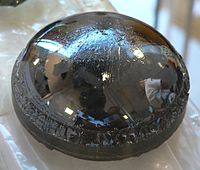
Photo from wikipedia
Encapsulation of electrocatalysts and photocatalysts with semipermeable nanoscopic oxide overlayers that exhibit selective transport properties is an attractive approach to achieve high redox selectivity. However, defects within the overlayers─such as… Click to show full abstract
Encapsulation of electrocatalysts and photocatalysts with semipermeable nanoscopic oxide overlayers that exhibit selective transport properties is an attractive approach to achieve high redox selectivity. However, defects within the overlayers─such as pinholes, cracks, or particle inclusions─may facilitate local high rates of parasitic reactions by creating pathways for facile transport of undesired reactants to exposed active sites. Scanning electrochemical microscopy (SECM) is an attractive method to determine the influence of defects on macroscopic performance metrics thanks to its ability to measure the relative rates of competing electrochemical reactions with high spatial resolution over the electrode. Here, we report the use of SECM to determine the influence of overlayer defects on the selectivity of silicon oxide (SiOx) encapsulated platinum thin-film electrocatalysts operated under conditions where two competing reactions─the hydrogen evolution and Fe(III) reduction reactions─can occur. After an SECM methodology is described to determine spatially resolved selectivity, representative selectivity maps are correlated with the location of defects that are characterized by optical, electron, and atomic force microscopies. This analysis reveals that certain types of defects in the oxide overlayer are responsible for ∼60-90% of the partial current density toward the undesired Fe(III) reduction reaction. By correcting for defect contributions to Fe(III) reduction rates, true Fe(III) permeability values for the SiOx overlayers were determined to be over an order of magnitude lower than permeabilities determined from analyses that ignore the presence of defects. Finally, different types of defects were studied revealing that defect morphology can have varying influence on both redox selectivity and calculated permeability. This work highlights the need for spatially resolved measurements to evaluate the performance of oxide-encapsulated catalysts and understand their performance limits.
Journal Title: ACS applied materials & interfaces
Year Published: 2022
Link to full text (if available)
Share on Social Media: Sign Up to like & get
recommendations!